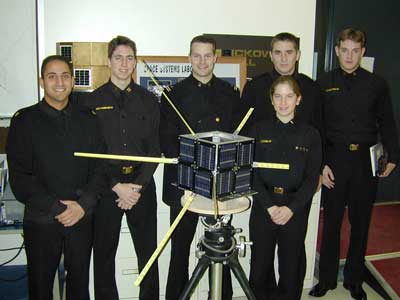 11 Nov 2001 @ 05:18, by Flemming Funch 11 Nov 2001 @ 05:18, by Flemming Funch
A satellite made by some students in a Naval Academy, for far less than the usual cost, using mostly components from Radio Shack, has been launched and is still working well, serving radio amateurs across the world. Even its builders are somewhat surprised that it worked. Instead of a $50,000 antenna system, the group used a metal tape measure. See article.
Here's a link to US Naval Academy Satellite Ground Station
Article here from Baltimore Sun:
Satellite on a shoestring going strong one month later
MidshipmenÂ’s project transmits ham signals
By Laura Sullivan Sun Staff November 6, 2001
After a month in orbit, a satellite built by Naval Academy midshipmen with off-the-shelf parts from Radio Shack is exceeding all expectations, sending and receiving messages from ham radio users around the world.
Academy students and professors hoped the satellite would work for a month, given that many of the parts they used have no history of operating in space. But since the satellite was launched from Kodiak, Alaska, on Sept. 30, it has shown no signs of degrading, and the group is hoping the satellite will work at least another year and maybe another five.
“If the satellite continues to work the way it has,” said Lt. Col. Billy Smith, an associate professor who has led the project, “others could draw the conclusion that for a simple, rugged satellite like the kind we built, it may be acceptable to go with cheaper parts you can get rather quickly and easily rather than space-rated parts.”
The academy is one of only about three undergraduate institutions that has attempted to build a satellite because of the expertise required and the prohibitive costs.
The television-sized satellite kept the midshipmen and advisers on the edge of their seats at the launch site for more than half an hour after the NASA rocket it hitched a ride on released it over the Persian Gulf. The National Aeronautics and Space Administration sponsored the launch of the Lockheed Martin Corp. Athena I rocket.
Three other satellites carried by the rocket had checked in, but the midshipmenÂ’s satellite seemed to miss a window of opportunity as it passed over a ground station in Kenya without sending a signal.
Finally, when the satellite passed over Alaska, the computer screens the midshipmen were watching began blinking as the satellite sent its first call sign. The group of midshipmen and a number of others from NASA burst into cheers, academy officials said.
“It was really great to finally see it pay off,” said Bob Bruninga, satellite project engineer at the academy, “to see that little box that we built here in this office up there 1,000 miles away talking to us.”
The first message relayed through the satellite came several hours later from an amateur radio user in Qatar in the Middle East.
Since the satellite was launched, more than 500 amateur radio users have bounced messages off it.
One of the more unusual groups to use it is made up of New Zealanders 60 and older who are walking from one end of their country to the other. They stumbled across the satellite a few weeks ago and have become frequent users, sending messages and their location to family members and local media keeping tabs on their journey.
On Wednesday, the satellite reached another milestone when it became the first to activate a Global Positioning System device that relays the satelliteÂ’s position directly to the public.
Radio users looking for a satellite to relay messages typically employ mathematical equations (or, these days, computer programs) to determine its whereabouts. When the academyÂ’s GPS device is on, the satellite sends a message with its position and speed that any ham radio user with a data receiver can pick up.
Other satellites that have GPS devices on board relay that information to organizations like NASA, some of which place the coordinates on the World Wide Web.
Three years ago, when midshipmen and members of the aeronautics department approached the school about building a satellite, officials balked at the half-million-dollar price tag. The group returned with a plan to build one for less than $50,000.
Instead of a $50,000 antenna system, the group used a metal tape measure. Instead of solar panels that cost $20,000 apiece, students bought panels the government uses to power emergency phones in deserts and national parks.
The midshipmen who took part in the project have all graduated, and the professors and advisers are turning their sights to building a more complex satellite. TheyÂ’re reviewing midshipmenÂ’s ideas for satellites that carry different types of sensors and communication systems, said aerospace engineering professor Daryl Bode.
ItÂ’s possible that the next satellite might make it to space in time to join the one in orbit, Smith said.
“This satellite has already surprised us,” Smith said, “and it will probably continue to.”
Copyright © 2001, The Baltimore Sun
|
|
 11 Nov 2001 @ 05:18, by Flemming Funch
11 Nov 2001 @ 05:18, by Flemming Funch